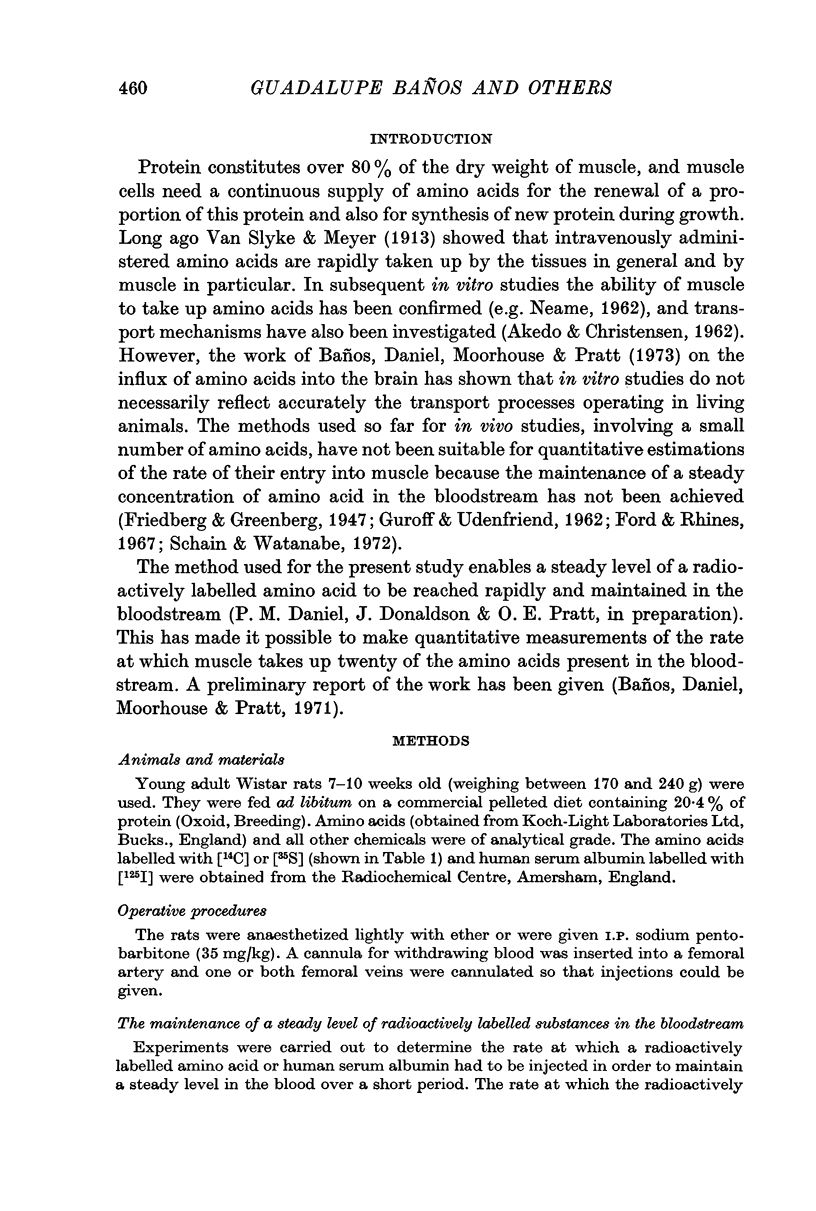Abstract
1. The rates of entry of twenty of the blood amino acids into skeletal muscle of living rats were measured directly by means of a technique which ensured that a steady concentration of a radioactively labelled amino acid is reached rapidly and is maintained in the bloodstream.
2. The rates of entry were measured in experiments of short duration to avoid possible artifacts caused by amino acids leaving the muscle or by their metabolism.
3. The entry rate of each amino acid increased in direct proportion to its concentration in the blood plasma over the physiological range.
4. The various amino acids had widely different rates of entry. These rates could not be correlated with the physicochemical properties of the amino acids.
5. Two amino acids, L-lysine and L-threonine, enter muscle against a concentration gradient, while in the case of a third, L-arginine, the blood concentration was raised high enough to induce saturation of the entry mechanism.
6. It is concluded that entry takes place in vivo by means of carrier-mediated transport processes with a high degree of specificity.
7. When the concentration of an amino acid in the bloodstream was increased to about twice normal the proportion of the additional amino acid that was taken up rapidly by the muscle was large enough, especially for the essential amino acids, to suggest that the tissue constitutes a quantitatively important storage system helping to regulate the concentrations of amino acids in the bloodstream.
Full text
PDF
















Selected References
These references are in PubMed. This may not be the complete list of references from this article.
- AKEDO H., CHRISTENSEN H. N. Nature of insulin action on amino acid uptake by the isolated diaphragm. J Biol Chem. 1962 Jan;237:118–122. [PubMed] [Google Scholar]
- Atkin G. E., Ferdinand W. Accelerated amino acid analysis: studies on the use of lithium citrate buffers and the effect of n-propanol, in the analysis of physiological fluids and protein hydrolyzates. Anal Biochem. 1970 Dec;38(2):313–329. doi: 10.1016/0003-2697(70)90456-2. [DOI] [PubMed] [Google Scholar]
- Baños G., Daniel P. M., Moorhouse S. R., Pratt O. E. The entry of amino acids into the skeletal muscle of the rat in vivo. J Physiol. 1971 Jul;216(1):34P–35P. [PubMed] [Google Scholar]
- Baños G., Daniel P. M., Moorhouse S. R., Pratt O. E. The influx of amino acids into the brain of the rat in vivo: the essential compared with some non-essential amino acids. Proc R Soc Lond B Biol Sci. 1973 Feb 27;183(1070):59–70. doi: 10.1098/rspb.1973.0004. [DOI] [PubMed] [Google Scholar]
- Bombara G., Bergamini E. Alpha-aminoisobutyric acid uptake in vitro by the rat extensor digitorum longus muscle after denervation and tenotomy. Biochim Biophys Acta. 1968 Mar 1;150(2):226–236. doi: 10.1016/0005-2736(68)90166-1. [DOI] [PubMed] [Google Scholar]
- Ford H., Rhines R. Amino-acid uptake compared in motor neurons, spinal cord grey matter, muscle and liver. J Neurol Sci. 1967 May-Jun;4(3):501–510. doi: 10.1016/0022-510x(67)90033-0. [DOI] [PubMed] [Google Scholar]
- GUROFF G., UDENFRIEND S. Studies on aromatic amino acid uptake by rat brain in vivo. Uptake of phenylalanine and of tryptophan; inhibition and stereoselectivity in the uptake of tyrosine by brain and muscle. J Biol Chem. 1962 Mar;237:803–806. [PubMed] [Google Scholar]
- MANCHESTER K. L., YOUNG F. G. Location 14C in protein from isolated rat diaphragm incubated in vitro with [14C] amino acids and with 14C02. Biochem J. 1959 May;72(1):136–141. doi: 10.1042/bj0720136. [DOI] [PMC free article] [PubMed] [Google Scholar]
- MANCHESTER K. L., YOUNG F. G. The effect of insulin in vitro on the accumulation of amino acids by isolated rat diaphragm. Biochem J. 1960 Jun;75:487–495. doi: 10.1042/bj0750487. [DOI] [PMC free article] [PubMed] [Google Scholar]
- NEAME K. D. Uptake of L-histidine, L-proline, L-tyrosine and L-ornithine by brain, intestinal mucosa, testis, kidney, spleen, liver, heart muscle, skeletal muscle and erythrocytes of the rat in vitro. J Physiol. 1962 Jun;162:1–12. doi: 10.1113/jphysiol.1962.sp006908. [DOI] [PMC free article] [PubMed] [Google Scholar]
- Neame K. D. A comparison of the transport systems for amino acids in brain, intestine, kidney and tumour. Prog Brain Res. 1968;29:185–199. doi: 10.1016/S0079-6123(08)64156-4. [DOI] [PubMed] [Google Scholar]
- Pozefsky T., Felig P., Tobin J. D., Soeldner J. S., Cahill G. F., Jr Amino acid balance across tissues of the forearm in postabsorptive man. Effects of insulin at two dose levels. J Clin Invest. 1969 Dec;48(12):2273–2282. doi: 10.1172/JCI106193. [DOI] [PMC free article] [PubMed] [Google Scholar]
- Schain R. J., Watanabe K. S. Distinct patterns of entry of two non-metabolizable amino acids into brain and other organs of infant guinea pigs. J Neurochem. 1972 Oct;19(10):2279–2288. doi: 10.1111/j.1471-4159.1972.tb01281.x. [DOI] [PubMed] [Google Scholar]
- WANG L. Plasma volume, cell volume, total blood volume and F cells factor in the normal and splenectomized Sherman rat. Am J Physiol. 1959 Jan;196(1):188–192. doi: 10.1152/ajplegacy.1958.196.1.188. [DOI] [PubMed] [Google Scholar]


